#hittite religion
Explore tagged Tumblr posts
Text
Ullikummi, Hittite Eschatology, and the Topography of the Spiritual Universe
Ουλλικούμμι, Χιττιτική Εσχατολογία και Τοπογραφία του Ψυχικού Σύμπαντος
Με θέματα χιττιτικής και χουριτικής κοσμογονίας, κοσμολογίας και εσχατολογίας είχα ασχοληθεί ήδη κατά την διάρκεια των σπουδών μου και από την αρχή των ανατολιστικών ερευνών μου. Όμως το αποκαλυπτικό χιττιτικό έπος χαρακτηρίζεται από μία ιδιαιτερότητα, η οποία δεν εντοπίζεται σε καμμία άλλη εσχατολογία και σωτηριολογία. Σε όλα τα άλλα κείμενα, σε κάθε άλλη θρησκεία, υπερβατική σοφία, και μυθολογία, όλη η αφήγηση περιστρέφεται γύρω από μία μεσσιανική μορφή Σωτήρα. Και το κείμενο είναι γραμμένο από ιερείς οι οποίοι περιπαθώς τον αναμένουν.
Αλλά στο Ουλλικούμμι οι περιγραφές γίνονται και η πλοκή υπάρχει με μόνο σκοπό να παρουσιαστούν τα καθέκαστα έτσι όπως αυτά επινοήθηκαν και επιτελέσθηκαν από τον Κουμαρμπί – μία παράξενη μορφή 'θεού', ο οποίος στρέφεται εναντίον της παλαιάς τάξης όψεων του Θείου, οι οποίες είχαν προκύψει με την Δημιουργία. Για τον σκοπό αυτό μάλιστα δημιουργεί τον λίθινο γίγναντα – θηρίο Ουλλικούμμι. Ο Κουμαρμπί επέχει δηλαδή την θέση του Δράκοντος (Σατανα) στην χριστιανική Αποκάλυψη και ο Ουλλικούμμι αντιστοιχεί στο Θηρίον (Αντίχριστο).

Στις 24 Νοεμβρίου 1990, είχα δώσει μία διάλεξη στην Νέα Ακρόπολη (Καλλιθέα) με τίτλο 'Μύθος και Αποκάλυψη από τους Χουρίτες και τους Χιττίτες ως τον Ιωάννη'. Το ηχητικό (σε όχι πολύ καλή κατάσταση) ευρίσκεται εδώ:
Το όλο θέμα εγείρει πολλά ερωτήματα είτε σε ιστορικό-γλωσσικό-λεξικογραφικό επίπεδο, είτε αναφορικά με θέματα ιστορίας θρησκειών και μυθολογίας, είτε ως προς τις ίδιες τις ψυχικές διεργασίες, οι οποίες επιτελέσθηκαν από τους Χιττίτες αρχιερείς και μύστες, οι οποίοι είχαν σκοπό να βιώσουν υπερβατικά το απώτατο μέλλον που αφηγήθηκαν έμμετρα στη συνέχεια.
Περιεχόμενα
Εισαγωγή
Ι. Ιστορικά στοιχεία
ΙΙ. Ιστορικο-θρησκευτικά στοιχεία και σύγχρονη επιστήμη
ΙΙΙ. Ανύπαρκτος ο Κουμαρμπί και Ναζιστές οι παραχαράκτες
ΙV. Κουμαρμπί και Τεσούμπ
V. Μεθοδολογικά προβλήματα
VI. Όταν ιερείς του Αντιχρίστου εσχατολογούν για τον Μεσσία
VII. Η νίκη του Μεσσία γραμμένη από αντι-μεσσιανικό χέρι
VIII. Ψυχικές ενέργειες και διαδικασίες κατά την υπερβατική βίωση του μέλλοντος
IX. Το ψυχικό σύμπαν και η τοπογραφία του
X. Ο χώρος της εκπόρευσης μορφών στο ψυχικό σύμπαν
XΙ. Ο άξονας Είναι και Γίγνεσθαι και η εκπόρευση μορφών
XII. Η υπερβατική βίωση του 'μέλλοντος' και οι νόμοι της
XIII. Όταν βλέπεις τον Τασμισού ως Ουλλικούμμι και ανάστροφα
XIV. Πως ο Κουμαρμπί-Σατανάς θα δημιουργήσει τον Ουλλικούμμι-Αντίχριστο
XV. Η νίκη του Τασμισού και η μεγάλη πολιτεία του Τέλους
XVI. Καισάρεια, Ιερουσαλήμ, Ήλιος, Κουμαρμπί και Γιαχβέ
XVII. Ουλλικούμμι: η σατανική αντι-Δημιουργία
Содержание
Введение
I. Элементы исторических свидетельств
II. Историко-религиозные данные и со��ременная наука
III. Несуществующий Кумарби и нацистские фальшивомонетчики
IV. Кумарби и Тешуб
V. Методологические проблемы
VI. Жрецы Антихриста и их эсхатологические ссылки на Мессию
VII. Победа Мессии написана антимессианской рукой
VIII. Духовные действия и процессы в трансцендентном опыте будущего
IX. Духовная вселенная и ее топография
X. Пространство эманации форм в духовной вселенной
XI. Ось Бытия и Становления и эманация форм
XII. Трансцендентальный опыт «будущего» и его законов
XIII. Когда вы видите Ташмишу (Tašmišu) как Улликумми, и наоборот
XIV. Как Кумарби-Сатана создаст Улликумми-Антихриста
XV. Победа Ташмишу (Tašmišu) и великий город Конца
XVI. Кесария, Иерусалим, бог Солнца, Кумарби и Яхве
XVII. Улликумми: сатанинское анти-творение
Contents
Introduction
I. Elements of historical evidence
II. Historical-religious data and modern science
III. The nonexistent Kumarbi and the Nazi forgers
IV. Kumarbi and Teshub
V. Methodological problems
VI. The priests of the Antichrist and their eschatological references to the Messiah
VII. Messiah's victory written by an anti-messianic hand
VIII. Spiritual actions and processes in the transcendental experience of the future
IX. The spiritual universe and its topography
X. The space of the emanation of forms in the spiritual universe
XI. The axis of Being and Becoming, and the emanation of forms
XII. The transcendental experience of the 'future' and its laws
XIII. When you see Tasmisu (Tašmišu) as Ullikummi, and vice versa
XIV. How Kumarbi-Satan will create Ullikummi-Antichrist
XV. The victory of Tasmisu (Tašmišu) and the great city of the End
XVI. Caesarea, Jerusalem, the Sun-god, Kumarbi and Yahweh
XVII. Ullikummi: the Satanic anti-Creation
--------------------------
Скачать всю статью в формате PDF: / Download the entire article in PDF: / Κατεβάστε ολόκληρο το άρθρο σε PDF:
#hittite religion#Hittites#Ullikummi#Teshub#Kumarbi#Upelluri#Anatolia#hittite mythology#eschatology#Hittite eschatology#Christian eschatology#Revelation by John#apocalyptic#End of Times#cosmogony#spirituality#spiritual universe#emanation of forms#SoundCloud
1 note
·
View note
Photo
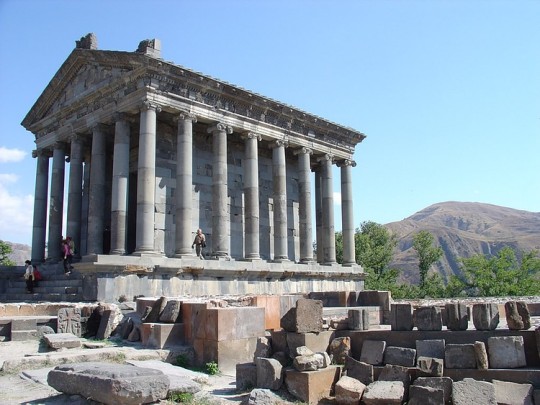
Ancient Armenia
Ancient Armenia, located in the south Caucasus area of Eurasia, was settled in the Neolithic era but its first recorded state proper was the kingdom of Urartu from the 9th century BCE. Incorporated into the Persian Empire of Cyrus the Great in the 6th century BCE, the Orontid dynasty ruled as Persian satraps, a function they performed for their next overlords the Macedonians and Seleucid Empire into the 3rd century BCE. Under the Artaxiad and Arsacid dynasties the country flourished but was often caught between the ambitions of Parthia and Rome, and then the Sasanian and Byzantine Empires. The boundaries of the state varied considerably over the centuries but such common factors as religion and language were united by long-lasting dynastic clans, which gave Armenia its own unique identity throughout antiquity.
Hayasa-Azzi (1500-1200 BCE)
The first identifiable culture in the region is the Hayasa-Azzi, an indigenous tribal confederation which flourished on the fertile plateau of ancient Armenia around Mount Ararat and parts of modern-day eastern Turkey between c. 1500 and c. 1200 BCE. The Hayasa-Azzi are the eponym of the Hay people, the term Armenians use to describe themselves and their state, Hayastan. Over time, the Hayasa-Azzi mixed with other ethnic groups and local tribes such as the Hurrians, Arme-Shupria, and Nairi, probably motivated by the need for defence against more aggressive and powerful neighbours like the Hittites and the Assyrians. They were probably infiltrated by the Thraco-Phrygians following the collapse of the Hittite Empire c. 1200 BCE. Eventually, these various peoples and kingdoms would be fused into the region's first recognisable and recorded state, the kingdom of Urartu from the 9th century BCE.
Continue reading...
91 notes
·
View notes
Note
What would Cassandra of Troy have worn? Would the Trojans also have Mycenaean fashion or is the any depiction of their fashion? I’ve been trying to design Cassandra but I really wanna be accurate so I thought I might as well ask someone who has more knowledge on it probably haha
That is a very good question given how Troy is a rather interesting city mythologically. Homer and other writers ironically do not refer to it as massively different than the rest of the Greek cities, or at least it highly depends. However the way Iliad is constructed, the Trojans do not follow massively different lifestyle than the Greeks, for they worship the same gods, they do not seem to have a language barrier and they have names that do often resemble the Greek names with some exceptions. This seems to be the case that Homer seems to be hinting to the previous taking of Troy by the hero Heracles around a generation or two prior (depending on the story). So Homer seems to be implying an osmosis of cultures between the Greeks and the locals which most likely were closer related to Hittite and Assyrians given how the Hittites existed at the are around till the 1300 BC as an empire before falling mostly under control of Assyrian empire. The fights or sociopolitical relations between Greeks and Hittites were already known by the data as well as the exchanges of knowledge between the two nations which probably the Trojan War is referencing to
Now of course it is not 100% correct to take Homer as a source that somehow Troy is a mixture of Greek and Anatolian characteristics given how no matter how accurate he is in certain things, his knowledge is still infiltrated by anachronisms so we still should take into account this to the back of our heads. And the fact that he depicts the Trojans worship the same gods or have similar customs and such might as well be his way to make the Trojans even more sympathetic to his viewers at that time so instead of showing them as the "bad barbarians that Greeks have to defeat" he made them all similar, with similar customs and similar cosmotheories with their only difference being the wall that protects Troy. I am not sure that Homer himself believed that Troy was a city of heavy Greek influence at least to THAT degree that he pictures but rather that he wanted to use that trick to help his listeners to remove their own personal biases and see the two sides as similar. Similarities definitely might have existed as well as osmosis of religions but his Trojans seem to be worshiping exactly the same gods which doesn't seem to be a realistic scenario
So if you are asking me how Cassandra might have been dressed I should say that if you are looking for historical locations and historical contexts then maybe is more valid to look at Assyrian or Hittite clothing and this is an old but very nice representation you can look like:

You can also look at the infamous image of Schliemann's wife who is wearing the jewelry they discovered during those excavations they did to the city of Troy (or at least the city that we have come to interpret by the evidence as Troy)

Mythologically though I think it would be perfectly valid to give her certain mycenaean characteristics to her clothing such as pieces of jewelry or skirts or veils or hats that were inspired by it given how she is a priestess associated with Apollo and all. Mycenean-inspired makeup might also work for her as well as an idea. Either way given the closeness of the two people with each other influences of Greek cities and such to Troy would be perfectly valid either way. To what degree is up for interpretation for your mythological depictions and ideas but we definitely expect to see plenty of similarities and exchange between the two.
I hope that answers your question a bit, I will be glad to elaborate further.
36 notes
·
View notes
Text
What's going on with Drolta?

Alright, I kinda promised @g-vlssz to also write down some historical context for this femme fatale. And admittedly she is the hardest character to figure out in this regard. Because we do not know a lot about her.
Don't get me wrong: We know two things about her. She is from Ancient Egypt and she was a priestess of Sekhmet. It stands to assume that she is also the reason, why Eszebet got to drink from Sekhmet.
Here is the issue: Ancient Egypt is a thing that was around for 3000 years. The oldest definite proof of worship of Sekhmet we have dates back to the 14th century BC. And as far as I know the last temple build for her was erected in the 1st century AD. So, we have a good 1500 years during which people definitely prayed to Sekhmet - and during which Drolta could theoretically have been created.
Given that we do not know how long vampires are around in the world of Castlevania, we also cannot use that information to somehow narrow it down. (I mean, according to Katie Silva Morana was from Ancient Sumer, which fell around 1750 BC.)
And once again, there is just the fact: Religions change over the centuries. The way we worship changes.
One way to go about is to look at her Blackness and make some interpretations about that, given that Egyptians usually are not Black but Arab. But... historically speaking this is a huge, huge controversy. Because whether or not Ancient Egyptians were Black is a big, big disccussion to this day. And to be honest: I am not gonna throw my hat into that ring.
There is one line, Drolta says, though, that makes me think that she might actually go back to about 1200 BC. Because she remembers her time as a priestess with the "smell of dead bodies". (I don't quite have the full quote there right now. But something along that lines.) And that one stood out to me, because the Egyptians were not that big on human sacrifice (outside from Retainer Sacrifices). Usually Sekhmet would get sacrificed either goats or bulls, but not humans. But... there is some kinda shacky evidence that while Egypt was having a war with the Hittites, which ended up very, very bloody, some prisoners of war got actually sacrificed to Sekhmet.
Going through all I have on Ancient Egypt and Sekhmet, this is the one instance I can find where there is (even though shacky) evidence of human sacrifice to Sekhmet.
But again, it is kinda hard to say.
Something that might play into her motivations, though, is the colonial history of Egypt. Which is a bit more complicated than a lot of white folks, who don't do history, give it credit for. Egyptian culture and mythology is fascinating. It is. Kid!me was not the first person who looked at that and was entranced. No, that goes back to even Ancient times when Greeks and Romans looked at Egypt and had the exact same reaction. Which makes it so complicated. Because, of course, colonialism of Egypt started a long, long time ago with the Greeks and Romans.
But... It was kinda different back then, mostly because Egyptian culture might have gotten mixed up with some of the Roman and Greek customs, but the Romans and Greeks never forbid or even much restricted Egyptian worship. Quite on the contrary, as they took up some of the gods, especially Isis, who became very popular both in Greece and Rome.
Now, if you are wondering: Why did worship of the Egyptian gods even end? You should know the answer: Christians.
See, the Romans were very okay with the worship of the Egyptian gods. Because they were polytheistic. But then along came Constantin, who not only moved the capital of Rome from, well, Rome, to Constantinople, but also made Christianity the main religion of the Byzantine Empire. Originally they kinda sorta still allowed other worship, but then along came Emperor Theodisius, who in line with his name was very much not okay with it. Not only did he had soldiers burn down temples throughout the Empire, he also forcefully converted people to Christianity. (As in: "Convert or die" forcefully.) Something people later would call the Heathen Hunts.
And with that... Well, with that the Egyptian gods became forbidden to pray to. Now, there were later again and again attempts to bring the worship back, but even after Egypt was no longer part of the Empire, it had Muslim rulers. And while Muslims at the time were mostly okay with Christians and Jews hanging around and doing their thing, they were often not as cool with the polytheistic worship of some other cultures.
And yeah, no matter what time Drolta comes from... She probably was there when they burned down the Sekhmet temples. And yes, she very much also was there when the Europeans came to Egypt and plundered the graves to then (ugh) fucking consume bits of mummy or use mummies in their paints.
So, like... If, after all of that, she decided "vampire messiah is gonna punish all the humans" sounded actually fairly good... I would not exactly hold it against her.
And that is all without going into the "she was probably Sekhmet's guardian the entire time or something" thing, that clearly is implied by the text.

#castlevania#castlevania netflix#castlevania nocturne#castlevania drolta#drolta#ancient egypt#sekhmet#colonialism#christianity#byzantium
147 notes
·
View notes
Note
With all these events that are happening i can't help but wonder about the cycle of rise and fall of civilizations especially for us Greeks
Did the ancient Greeks think it was hopeless when society as they knew it changed and collapsed in front of them? Did the Byzantines thought about the end of times when the Ottomans invaded?
How are many Greeks nostalgic about the past but don't want to make modern Greece better and the cycle repeats.
To be honest, I don't think this way a lot. I think the "fall of a civilization" applies only to people whose culture and identity both faded forever (i.e Hittites, Babylonians, Inca). Other than that, a civilization may diminish or adapt to its times in order to survive. The historian Roderick Beaton says Greeks were at a constant process of reinventing themselves and thus surviving and I find myself agreeing with this perspective. If the Greek civilization had fallen, then there would be nothing for us to hold on to or build our identity on, no language surviving, no Greek Orthodoxy practiced, no extant folklore and legends (modern groups of people who suddenly build up a lore to connect themselves with old civilizations on the basis of fabricated data obviously don't count). Admittedly, to the outside eye those nuances may be hard to spot, I mean, what makes one culture an adaptable survivor or fallen and replaced by a similar yet disconnected one or downright fabricated but either way I don't think the Greek civilization has ever fallen. I think similarly about the Iranians (Persians), the Indians, the Chinese, the Japanese etc None of these cultures are exactly what they were like but they are adapting, evolving and surviving... our era is not an era cultivating cultures after all. Despite their positives, technology and globalisation have caused the dramatic decrease of independent thought and expression.
Anyway, I don't think Ancient Greeks ever thought of a fall of their civilization or an end of an era. Perhaps they feared that during the Persian invasions, however ancient people were far more adaptable and pragmatic than nostalgic - it's no coincidence that the small city states did not oppose much to the Persian forces. It was only a few powerful city states like Athens and Sparta that could "afford" being romantic and organize a defense. But against all odds the defense proved strong and the Persian danger was dealt with.
When Greeks were conquered by the Romans, there wasn't a "change and collapse of the society as they knew it". Of course, it's rarely mentioned by all the Greco-Roman fans but initially Romans caused countless casualties and destroyed many great Greek cities. However, they rebuilt a lot of them and established a lifestyle very similar to the one Greeks already had and the Greeks were free to act exactly as they used to and prosper, so there ultimately wasn't a collapse of the Greek civilization or the society there as they knew it either.
The rise of Christianity would have only been viewed as the collapse of the society as they knew it to those who adhered very persistently to the old religion. But many Greeks also adopted the religion very eagerly. People keep on talking about the persecutions of pagans by Christians, which definitely happened, but they don't talk about why the Orthodox and the Catholic churches are full of proto-Christian martyr saints, aka Christian people who were persecuted, tortured and killed by pagans. A great number of them were Greeks who had eagerly adopted the new religion. The New Testament is proof of the Greeks' genuine interest in Christianity - not only it is written in Greek but a lot of it is the epistles of Paul to various Greek Christian groups i.e Thessalonians, Corinthians, Ephesians, Philippians. Besides, nowadays we tend to perceive these things as one-time shocking changes. But this is not how things happened in reality; changes were slow, gradual, curiosity hand in hand with hesitation, periods of peace switching with ones of persecution from either side. So I don't think there was a certain point in time were Greeks would altogether think of the "fall of their civilization". Again, many of the Greeks wanted these changes to take place anyway.
The one time in early antiquity that could be perceived as a fall was the Dark Ages / the Homeric Age, about which too little historical evidence has been found. And yet I am a little sceptical about this too. The reason of my confusion is that after this 400 years long era of supposed nothingness and regression and civilization collapse the very first thing we get is BOOM! Homeric Epics! How is this even possible? Imagine this in pseudo - evolutionary terms; something happens to a horse and it immediately downgrades to a frog and then BOOM inexplicably it evolves to a chimpanzee! Something's not right there. I think even the Dark Ages were not as dark as historians believe and most of these speculations are caused due to a lack of archaeological evidence (whatever happened to it) than due to the factual fall of the civilization. However, something definitely happened there because there is a sense of nostalgia and admiration amongst the Archaic Greeks for the heroes of old... My personal speculation is that the Mycenaean Civilization was indeed pressed by the change of times, wars, social class revolutions, maybe natural disasters but it did go into a phase of incubation, adapting and reinventing itself, gradually morphing into the culture of Archaic Greece. It did not fall because if it had indeed fallen, then it would be impossible for the first thing to be produced after a civilization's fall to be epic poetry of the highest literary form of the very language the fallen civilization had! Oh, and the Olympic Games too! I don't think that's how civilization collapses work. I don't know why there is a lack of archaeological evidence but I think this very lack is skewing our perception of the Dark Ages, which I thus much prefer to call with its alternative name "Homeric Age". (It's also called "Geometric period" but that's not dramatic enough XD.)
The one time Greeks (or now Romans, but obviously not the Latin speaking Ancient Romans originating from where modern day Italy is, which is why it is so much more convenient to say Byzantines when speaking to foreigners that need to understand you're not talking about Latin speaking Ancient Romans) must have thought the end of an era was coming was indeed during the last years of the Eastern Roman Empire. Not just due to the Ottomans though, but also due to the Latins (Franks, Venetians, Crusaders) who were the ones who actually destroyed the empire and then the Ottomans just found shards to sit on. The last years of the Byzantine era is probably the first time we see true panic and despair and grief in all their majesty in the historical documents. Furthermore, after living in one single state for so long, Greeks had finally developed a communal sense of existing, a nationhood. Based on late Byzantine documents, it seems the Greeks now feared the end of Ancient Greek legacy and Roman / Romaic (medieval Christian Greek) culture was imminent with the emergence of the Ottoman Turks.
This is the one time the Greek civilization came close to fall for good. But it is true that the Ottoman Turks allowed subjects to practice their religion (obviously not in an equally free, safe and unapologetic way as the Muslims could but still) and speak their tongue (obviously not supporting it to be taught in schools - I mean, there weren't schools apart from religion focused very basic privately paid schools here and there, especially in the Greek mainland - but still) and with great difficulties and low odds working in its favour the Greek civilisation persists. Of course it's not the same as it was in 1500 BC or in 450 BC or in 1100 AD but that's not because it has fallen 50 times, it is because all surviving old cultures survived exactly because they were able to adjust according to their times, the changes and the dangers they confronted by adopting what they needed to adopt and preserving what they needed to preserve.
I agree about the Modern Greeks though. The Modern Greeks have indeed lost their focus but I don't think it's going to be forever. The main problem of the Modern Greeks is how they are stuck on reminiscing a past long gone, a past they have not even experienced first hand or even studied thoroughly enough, instead of looking to the future and seing what they can do for it as the independent grown people that they are. They waste time and motivation at always comparing themselves unfavourably to what ancient ancestors would have done, which is an incredibly stupid way to evaluate challenges anyway, because ancestors were a product of their own times and we can not in any way predict how they would act or be like in our times.
By the way, I read a very interesting article about 1821 that I intend to translate in English and post here at some point, and I was thinking, people talk and talk about Greece having fallen, about Greece not being what it was, about Greece having a financial crisis and being weak, and I am just thinking... people have no idea about what kind of leaps Greece has done the last 200 years...
14 notes
·
View notes
Note
i love thinking about apollos anatolian origins 😵💫
It stews in the back of my head too :3
There was this really good podcast on Spotify I found about Ancient Greece, and I listened to his Apollo episode first (because I honestly can't stomach the ones who paint him as 'terrible assaulter'/'epitome of the patriarchy'. Can't stand it. Seriously, there was this so-called 'feminist' mythology podcast i found and I Noped out of there as fast as I could - she didn't even mention Eros's involvement in the Daphne myth! She immediately went 'Apollo: the man who doesn't know the meaning of No' and I was like I'M OUTTA HERE.)
(It's very hard to find good Apollo content out there when you have educated yourself on what he's actually like :( )
(At least you immediately know those people didn't do their research shrug)
Thankfully, this one had a really good, really in-depth discussion about Apollo; his origins, his domains, his myths, ect!
COMPLETELY FREE OF BIAS TOO! HE JUST GIVES YOU THE FACTS, THE SYMBOLISM OF THE MYTHS, HOW THE CULTURE INFLUENCED THEM, ECT!
On my first (and only rn) listen I was like "damn i need to take notes on this sometime" that's how in-depth it is!
Here's the episode link if anybody is interested, btw!
What's cool is that he said that before Apollo came along, oracles and the like weren't as common in Greece - they existed, because Gaea was a thing - however, when he was imported in (possibly also with Leto! She has Anatolian origins too!), oracles became more of a thing as Apollo's popularity skyrocketed!
If you look at the number of Oracles Apollo had, you'd also notice that a lot of them are in Anatolia (Turkey today)!. Didyma, Miletus, Claros, ect ect! I think this just adds to the theory that Apollo's main origins come from Anatolia! When he moved to Greece, oracles came with him!
Which is so cool because in my drafts I currently have a picture of a webchart I made of Apollo's (many) domains, and I narrowed down the ones I think are his Big Ones - and Prophecy is one of them.
Very cool that Prophecy has always been part of him <3
Also, Apollo has many cities he is the patron of in Anatolia - Troy is obvious, but the island of Tenedos was his too (his son Tenes founded the city there), and he was the patron of Miletus (the city where he met Branchus btw for my Branchus fans out there)!
And going to Leto real quick, her migration from Anatolia religion to Greece's is probably represented in the Hymn to Apollo! Sometimes myths about wandering from place to place were meant to symbolize the importation of a god (Aphrodite floating ashore of Cythera, for example), and Leto...well, she was doing a lot more than the typical wandering in the hymn, but it still fits!
Some versions say she was guided to Delos by wolves from Hyperborea, others say Boreas helped her escape Python, still others claim a rooster was present when she finally was able to give birth and thus became her sacred animal (also she apparently gave birth to Apollo as a wolf? I don't quite remember which version says that but it's something I've heard XD).
Also Delos was very self-conscious about Apollo being born on it because it was afraid he would judge it for not being up to typical island standards XD
Moving to Apaliunas now! He's a Hittite god, but I haven't been able to find out of what :( The main piece of evidence we have of his relation with Apollo is Troy - Apaliunas was the god of Wilusa, who has been found out to be another name for Troy! There was a treaty signed between Wilusa and another city, and the representative of Wilusa's name was commonly translated to "Of Ilios" - and Ilios was another name for Illium, aka Troy.
(Fun fact: The son Apollo had with Ourea was named Ileus, after Troy! They are but a footnote in mythology but I made them Important in my Troy fic XD)
Plus, Apaliunas's name was connected to the Hittite reflex of Apeljōn, which scholars have theorized to be an early form of Apollo's name - remember Apollon? :D
Apollo also has connections to various other deities - the Italian Etruscan god Apulu (Aplu), the Celtic god Grannus, his Egyptian equivalent is Horus and his Phoenician one is Resheph! He's also been identified with Baldur from Norse mythology.
Apollo be wearing that trenchcoat, and he is wearing it well XD
#the oracle speaks#ramblings of an oracle#apollo#apollo deity#greek myths#greek history#greek myth#greek gods#greek mythology#ancient greece
60 notes
·
View notes
Text
wikipedia tabs i have open on new year's day
Railgun
Gunboat
Loess
Kamchatka Peninsula
Ansible
Hainish Cycle
Key deer
Mount Rainier
Socialism with Chinese characteristics
Xi Jinping Thought
Historical nihilism
Three Represents
Scientific Outlook on Development
Blue crab
Callinectes sapidus
Crab cake
Diamondback terrapin
Turtle soup
Yellow-bellied slider
Red-eyed slider
Littoraria irrorata
Halite
Appanage
Princess
Penicillin
Raffinate
Kaali crater
Hittite mythology and religion
Augury
Dovecote
Fasenjān
Confucianism
Messier 87
Elliptical galaxy
Whirpool Galaxy
Spiral galaxy
Pinwheel Galaxy
Milky Way
Sagittarius A*
Messier 87
History of Christian universalism
Kardashev scale
Grand duke
PSR B1257+12
PSR B1257+12 B
55 Cancri e
Carbon planet
Chthonian planet
Tholin
Luna (goddess)
European rabbit
Heroin
Abscess
Acedia
Weltschmerz
Razor
Synthetic fiber
Marshal of Yugoslavia
65 notes
·
View notes
Text
Funny or interesting Epic of Gilgamesh tidbits
Nobody actually says Enkidu’s name before Shamhat shows up. His creation is essentially impersonal, and this is something that is brought up by Humbaba during the fight. There’s a pretty sound theory that Enkidu urges Gilgamesh to ignore his pleas specifically because Humbaba mocked his lack of biological parents. Note that at this point in the narrative Enkidu does not lack parents altogether, though, since Ninsun outright calls him a member of her family and de facto her foster child before he embarks on the journey to the cedar forest with Gilgamesh.
When Enkidu curses Shamhat on his deathbed for setting off the chain of events which lead to his incoming death, Shamash appears to him to inform him this was rude and uncalled for and urges him to bless her instead because he wouldn’t met Gilgamesh without her. Enkidu actually does listen and promptly does so... expressing the wish for her to supplant the wife of someone affluent. While the passage also has Enkidu curse the anonymous hunter, Shamash is not concerned about him, so he does not get an apology.
Speaking of the hunter - his name is only preserved in the Hittite adaptation of the epic, though it is Akkadian nonetheless. He is named Shangashu, which means “murderer”. His parents must have hated him.
Utnapishtim actually curses the ferryman who brought Gilgamesh to his realm, Urshanabi, presumably specifically because he did that. Urshanabi due to being out of job then tags along with Gilgamesh for the rest of the story, and the final words are addressed to him. He’s probably the most major character in the epic with virtually no presence in adaptations.
In the Hittite adaptation of the epic, Gilgamesh visits the personified sea, something virtually unheard of in Mesopotamia for the most part, and not exactly common in Hittite religion either, presumably a reflection of the popularity of the sea among Hurrians (his Hurrian sidekick Impaluri is there too). The sea promptly curses him, as far as the surviving fragments go just because.
The Hurrian version, which is too fragmentary for a proper translation, in addition to replacing Ishtar and Shamash with their Hurrian counterparts, Shaushka and Shimige, apparently inserts the de facto main character of most surviving Hurrian myths, Teshub, into the narrative.
It is also possible that there was a Hurrian rewrite of the epic focused on Humbaba, in which he either survived or was portrayed as a tragic figure. Granted, the latter is not really unusual, since the gods’ anger at Humbaba’s death does appear to reflect the opinion of the epic’s compilers, and Humbaba is well attested as a protective apotropaic figure.
For sources on all of the above and more, see my recently finished rewrite of the article on EoG characters on wikipedia. Most are open access!
349 notes
·
View notes
Text
From what we can figure, the sun was a female entity in Minoan religion (Nanno et al 2013), possibly related to the “snake goddess”, perhaps via a “pan-goddess” caveat. Many greek goddesses (Rhea, Demeter, Artemis, Cybele, et cetera) are associated with lions; the lioness as a sun symbol is well attested in Hittite and Egyptian religion, and was probably a common Middle Eastern motif wherever solar goddesses were relevant.
The bull was relevant in minoan religion to the point that it is one of the most well known aspects of this culture. The “Moon Bull”, as it is, has been connected to the sun by classical authors, exposing the typical “every god is a sun god, every goddess is a lunar goddess” nonsense. However, the bull is a generally lunar symbol in the Near East (semetic, where it is connected to the many moon gods, anatolian, where it is similarly connected to the moon gods, even greek and egyptian, where it is associated with Selene and Dionysus and Osiris respectively), and a masculine moon god role can comfortably be implied.
So, basically:
Lion Sun Goddess
Bull Moon God
However, this leaves us with two hiccups:
– Talos, the “greek Helios”, which is the de facto word for “sun” in Crete and whose use may extend further back in time. Zeus as Tallaios is a solar god. That said, since Zeus Tallaios is more of a “death and rebirth” deity (mind you, almost no solar deity is one), it may call into question the status of Talos as originally a sun god.
– The Minotaur’s true name is Asterion. This has been interpreted as a vestige of solar symbols, since the “labyrinth” would instantly become the zodiac. That said, “Aster” and it’s derivatives are rarely applied to the sun outright, and could suggest a more esoteric stellar meaning.
It’s possible that, like ancient egypt, russia and india, the Minoan Civilisation perceived the sun as both male and female depending on the context. I’m leaning with a generally “Sun Lioness” for a solar figure and Talos as specifically the body of the sun.
13 notes
·
View notes
Text
Discovering the world
Lebanon 🇱🇧
Basic facts
Official name: الجمهورية اللبنانية (al-Jumhūrīyah al-Lubnānīyah) (Republic of Lebanon)
Capital city: Beirut
Population: 5.3 million (2023)
Demonym: Lebanese
Type of government: unitary parliamentary republic
Head of state: vacant (President)
Head of government: Najib Mikati (Prime Minister)
Gross domestic product (purchasing power parity): $78.23 billion (2022)
Gini coefficient of wealth inequality: 31.8% (medium) (2011)
Human Development Index: 0.723 (high) (2022)
Currency: pound (LBP)
Fun fact: It hosts the highest number of refugees per capita and per square kilometer.
Etymology
The country’s name comes from Mount Lebanon, whose name derives from the Phoenician root lbn, meaning “white”.
Geography
Lebanon is located in West Asia and borders Syria to the north and east, Israel to the south, and the Mediterranean Sea to the west.
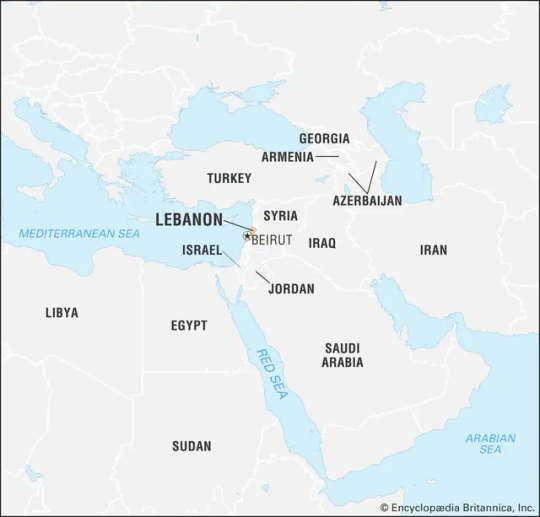
There are two main climates: Mediterranean-influenced humid continental in the center and east and hot-summer Mediterranean in the rest. Temperatures range from 11 °C (51.8 °F) in winter to 30 °C (86 °F) in summer. The average annual temperature is 20.9 °C (69.6 °F).

The country is divided into nine governorates (muḥāfaẓāt), which are further divided into twenty-five districts (aqdyah). The largest cities in Lebanon are Beirut, Tripoli, Jounieh, Zahlé, and Sidon.
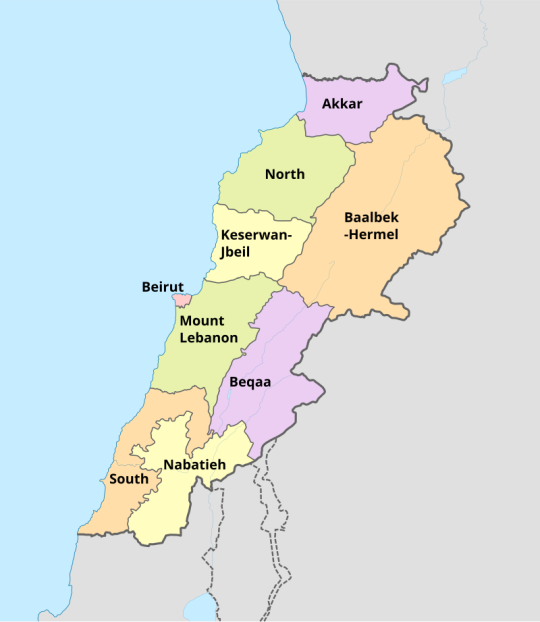
History
2500-64 BCE: Phoenicia
1650-1180 BCE: Hittite Empire
1550-1069 BCE: New Kingdom of Egypt
550-332 BCE: Achaemenid Empire
332-64 BCE: Seleucid Empire
64 BCE-394 CE: Roman Empire
394-635: Byzantine Empire
619-629 CE: Sasanian Empire
636-661: Rashidun Caliphate
661-750: Umayyad Caliphate
750-1517: Abbasid Caliphate
1099-1291: Kingdom of Jerusalem
1102-1289: County of Tripoli
1250-1516: Mamluk Sultanate
1516-1842: Emirate of Mount Lebanon
1516-1918: Ottoman Empire
1843-1861: Double Qaim-Maqamate of Mount Lebanon
1860: civil conflict in Mount Lebanon and Damascus
1915-1918: Great Famine of Mount Lebanon
1920-1926: State of Greater Lebanon
1923-1946: Mandate for Syria and the Lebanon
1926-1943: Lebanese Republic
1943-present: Republic of Lebanon
1948: Arab-Israeli War
1975-1990: Lebanese Civil War
1976-2005: Syrian occupation
1985-2000: South Lebanon conflict
2005: Cedar Revolution
2006: Lebanon War
2006-2008: protests
2007: Lebanon conflict
2011: Intifada of Dignity
2019: 17 October Revolution
2020: Beirut explosion
2021: Beirut clashes
Economy
Lebanon mainly imports from the European Union, Türkiye, and China and exports to the European Union, the United Arab Emirates, and Switzerland. Its top exports are diamonds, polyacetals, and gold.
It has natural gas, limestone, oil, and salt reserves. Services represent 83% of the GDP, followed by industry (13.1%) and agriculture (3.9%).
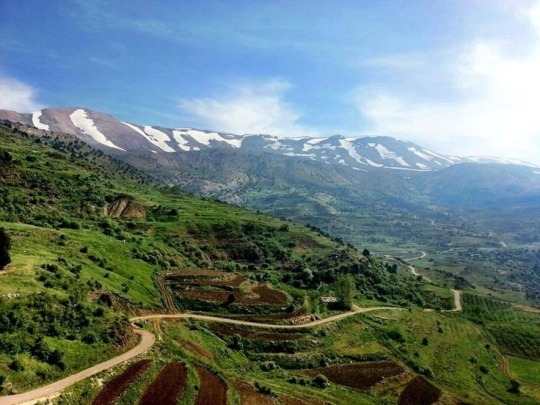
Lebanon is a member of the Arab League, la Francophonie, and the Organization of Islamic Cooperation.
Demographics
95% of the population is Arab, while Armenians make up 4%. The main religion is Islam, practiced by 55% of the population, 27.6% of which is Sunni.
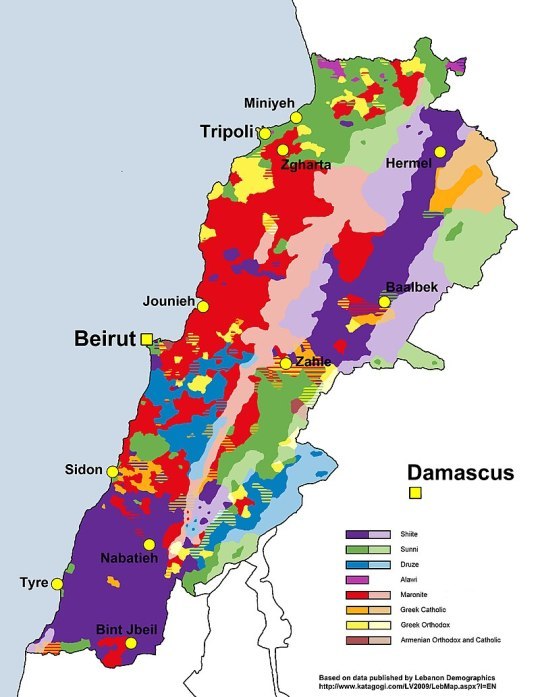
It has a negative net migration rate and a fertility rate of 1.7 children per woman. 89% of the population lives in urban areas. Life expectancy is 78.3 years and the median age is 31.3 years. The literacy rate is 96.7%.
Languages
The official language of the country is Arabic. French is spoken by 40% of the population.

Culture
Lebanese culture has Persian, Greek, Roman, Arab, Ottoman, and French influences. Lebanese people are very gregarious.
Men traditionally wear a shirt, a dark vest, baggy pants (sherwal), a belt, and a headdress. Women wear a shiny dress (gambaz), a wide belt, and a conical hat with a long piece of silk (tantur).
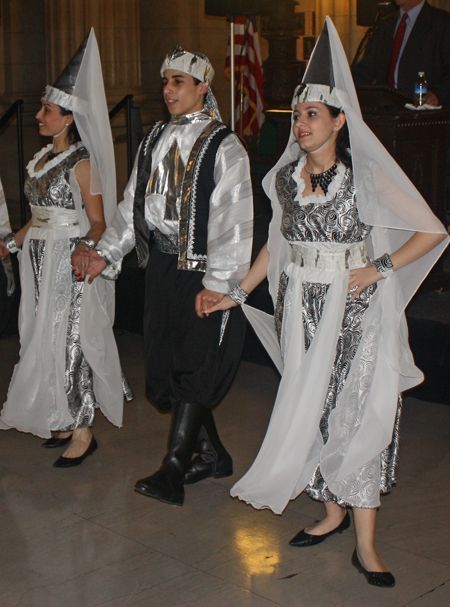
Architecture
Traditional houses in Lebanon are made of stone and wood and have flat roofs and terraces.
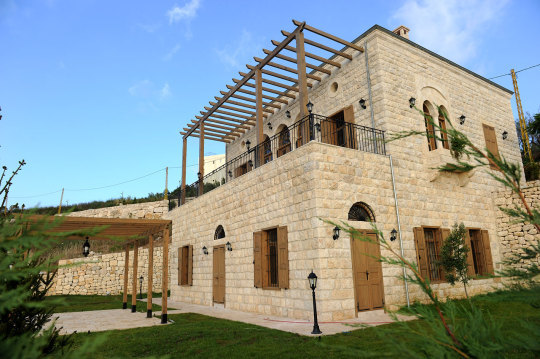
Cuisine
The Lebanese diet is based on fish, meat, pulses, and vegetables. Typical dishes include bamieh bi-zeit (okra and tomato stew), kibbeh (fried balls made of spiced meat and bulgur), sayadieh (seasoned fish and rice), sfouf (an almond-semolina cake), and tabbouleh (a salad of bulgur, onion, tomatoes, and parsley).

Holidays and festivals
Like other Christian and Muslim countries, Lebanon celebrates Epiphany, Armenian Christmas, St. Maroun Day, Feast of the Annunciation Day, Good Friday, Easter Sunday, Assumption, Christmas Day, Islamic New Year, Ashura, Mawlid, Eid al-Fitr, and Eid al-Adha. It also commemorates New Year’s Day and Labor Day.
Specific Lebanese holidays include Rafic Hariri Memorial Day on February 14, Liberation and Resistance Day on May 25, and Lebanese Independence Day on November 22.

Independence Day
Other celebrations include the Aerial and Circus Arts Festival, the Baalbeck International Festival, which features dance and music performances, and the Beiteddine Art Festival.
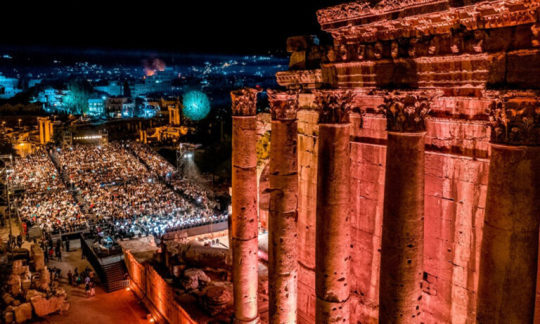
Baalbeck International Festival
Landmarks
There are six UNESCO World Heritage Sites: Anjar, Baalbek, Byblos, Ouadi Qadish (the Holy Valley) and the Forest of the Cedars of God (Horsh Arz el-Rab), Rachid Karami International Fair-Tripoli, and Tyre.
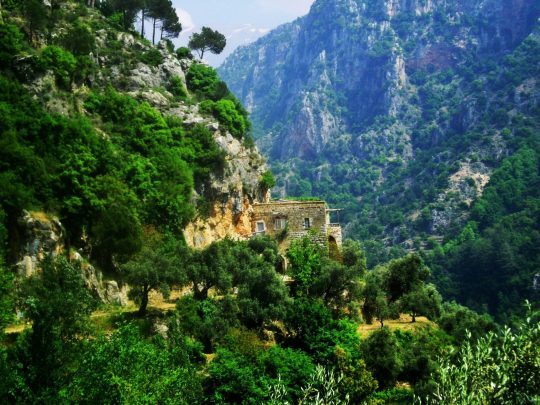
Ouadi Qadish and the Forest of the Cedars of God
Other landmarks include Jabal Moussa, the Mohammad Al-Amin Mosque, the Moussa Castle, Our Lady of Lebanon, and the Tripoli Citadel.
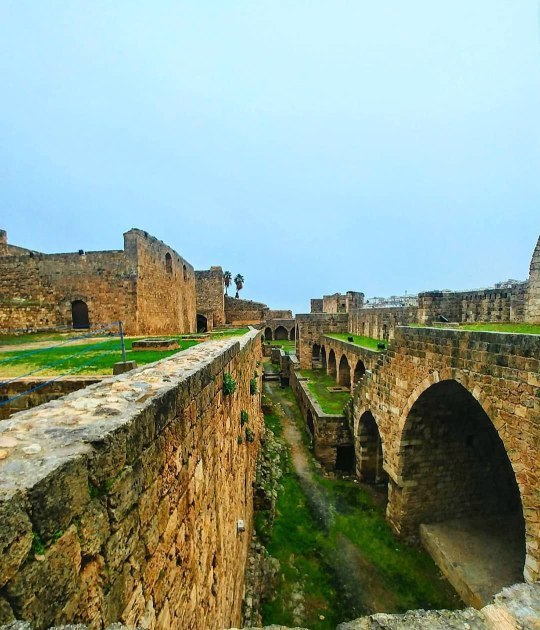
Tripoli Citadel
Famous people
Amin Maalouf - writer
Elie Saab - fashion designer
Fares Fares - actor
Jackie Chamoun - skier
Khalil Beschir - racing driver
May Ziade - poet and writer
Nadine Labaki - actress
Najwa Karam - singer
Ragheb Alama - singer
Rima Fakih - model

Rima Fakih
You can find out more about life in Lebanon in this post and this video.
7 notes
·
View notes
Text
Biblical Evidence of “divinely ordained” imperialism, settler colonialism, and indigenous genocide by the “God” YHWH
The UN Genocide Convention that was ratified in response to the Holocaust during WWII contains 5 “acts committed with intent to destroy, in whole or in part, a national, ethnical, racial or religious group.” These five acts include:
1. killing members of the group
2. causing them serious bodily or mental harm
3. imposing living conditions intended to destroy the group
4. preventing births
5. forcibly transferring children out of the group
The convention further criminalizes "complicity, attempt, or incitement/encouragement” of genocide.
Monotheistic, Abrahamic Yahwist Jews are NOT the indigenous inhabitants of the so-called “Holy Land.” These people and their ancestors are the violent colonizers and perpetrators of genocide and ecocide on indigenous western Levantine land, and there are many biblical scriptures that confirm this and even fit the criteria for the biblical Israelites to be criminally tried for genocide under the UN Convention.
The fact that millions of people worldwide have and still blindly follow the narcissistic abusive, toxic, malignant Abrahamic religions, despite the fact that it all contains this sort of indignity (and so much more) within it disgusts me, saddens me, confuses me, and enrages me. I have personally connected so many of our world’s problems and injustices with the creation and maintenance of Abrahamic religion and Abrahamic religious supremacy.
If we are to have universal peace, love, joy, compassion, and liberation, all toxic, malignant, narcissistic abusive religions, theologies, ideologies, etc. must be abolished for good! The top of these are the Abrahamic religions, because due to centuries of violent imperialism, colonization, genocide, and ecocide, these religions have the most brainwashed and/traumatized converted victims (AKA “followers”).
We all need to return to our pre-Abrahamic, indigenous “pagan” roots that we all have. And all those who may want to jump to conclusions and accuse me of being antisemitic or Islamophobic—let’s not be hasty and irrational. Jews need to remember that there was widespread “pagan” polytheistic Judaism before the creation and oppressive maintenance of the toxic and malignant monotheistic Yahwist Judaism. Yahwist Judaism is NOT the indigenous Jewish religion and the “Holy Land” supposedly set apart by their “God” YHWH is NOT the indigenous Jewish land either. And Muslims must remember that Islam is simply a 700s AD plagiarization of Christianity and Yahwist Judaism, and before the violent takeover of these religions, their indigenous ancestors practiced their respective native polytheistic religions. All of these should also remember that they are ALL semitic-speaking peoples, therefore the term “antisemitism”—which has been now ceaselessly weaponized by Zionist genocide apologists—needs to be repaired to where it’s not exclusive to only Jews, but defines ALL semitic-speaking peoples, including Arabs.
Pre-Abrahamic Jews were EQUALS with all other pre-Abrahamic pagans/Gentiles until the creation and maintenance of monotheistic Yahwist Judaism, in which Jews were supposedly “set apart” and “set above” all other “pagan”/“gentile” peoples of the world by this “God” YHWH. Tell me, how is this theology ANY DIFFERENT than, for example, Adolf Hitler claiming that his white Aryan race was the superior human race of the entire earth? How is Adolf Hitler’s ideology ANY DIFFERENT from the Bible, in which the Israelites were repeatedly commanded and encouraged by their “God” YHWH to violently colonize and commit genocide against indigenous western Levantine peoples?
Exodus 23:23-33
“For mine Angel shall go before thee [Israelites], and bring thee in unto the Amorites, and the Hittites, and the Perizzites, and the Canaanites, the Hivites, and the Jebusites: and I will cut them off. Thou shalt not bow down to their gods, nor serve them, nor do after their works: but thou shalt utterly overthrow them, and quite break down their images. And ye shall serve the LORD your God, and he shall bless thy bread, and thy water; and I will take sickness away from the midst of thee. There shall nothing cast their young, nor be barren, in thy land: the number of thy days I will fulfil. I will send my fear before thee, and will destroy all the people to whom thou shalt come, and I will make all thine enemies turn their backs unto thee. And I will send hornets before thee, which shall drive out the Hivite, the Canaanite, and the Hittite, from before thee. I will not drive them out from before thee in one year; lest the land become desolate, and the beast of the field multiply against thee. By little and little I will drive them out from before thee, until thou be increased, and inherit the land. And I will set thy bounds from the Red sea even unto the sea of the Philistines, and from the desert unto the river: for I will deliver the inhabitants of the land into your hand; and thou shalt drive them out before thee. Thou shalt make no covenant with them, nor with their gods. They shall not dwell in thy land, lest they make thee sin against me: for if thou serve their gods, it will surely be a snare unto thee.”
Exodus 23:23-33 KJV
This particular scripture fits the UN criteria for genocide. First, killing members of the group:
“For mine Angel shall go before thee, and bring thee in unto the Amorites, and the Hittites, and the Perizzites, and the Canaanites, the Hivites, and the Jebusites: and I will cut them off.”
“I will send my fear before thee, and will destroy all the people to whom thou shalt come”
Second, causing them serious bodily and/or mental harm:
“thou shalt utterly overthrow them, and quite break down their images.” (Cultural genocide)
“I will send my fear before thee, and will destroy all the people to whom thou shalt come”
“I will send hornets before thee, which shall drive out the Hivite, the Canaanite, and the Hittite, from before thee.
Third, imposing living conditions intended to destroy the group:
“I will send my fear before thee, and will destroy all the people to whom thou shalt come“
“I will not drive them out from before thee in one year; lest the land become desolate, and the beast of the field multiply against thee. By little and little I will drive them out from before thee, until thou be increased, and inherit the land.”
Deuteronomy 20:10-20
“When thou comest nigh unto a city to fight against it, then proclaim peace unto it. And it shall be, if it make thee answer of peace, and open unto thee, then it shall be, that all the people that is found therein shall be tributaries unto thee, and they shall serve thee. And if it will make no peace with thee, but will make war against thee, then thou shalt besiege it: and when the LORD thy God hath delivered it into thine hands, thou shalt smite every male thereof with the edge of the sword: but the women, and the little ones, and the cattle, and all that is in the city, even all the spoil thereof, shalt thou take unto thyself; and thou shalt eat the spoil of thine enemies, which the LORD thy God hath given thee. Thus shalt thou do unto all the cities which are very far off from thee, which are not of the cities of these nations. But of the cities of these people, which the LORD thy God doth give thee for an inheritance, thou shalt save alive nothing that breatheth: but thou shalt utterly destroy them; namely, the Hittites, and the Amorites, the Canaanites, and the Perizzites, the Hivites, and the Jebusites; as the LORD thy God hath commanded thee: that they teach you not to do after all their abominations, which they have done unto their gods; so should ye sin against the LORD your God. When thou shalt besiege a city a long time, in making war against it to take it, thou shalt not destroy the trees thereof by forcing an axe against them: for thou mayest eat of them, and thou shalt not cut them down (for the tree of the field is man's life) to employ them in the siege: only the trees which thou knowest that they be not trees for meat, thou shalt destroy and cut them down; and thou shalt build bulwarks against the city that maketh war with thee, until it be subdued.”
Deuteronomy 20:10-20 KJV
This biblical scripture fits the UN criteria for genocide. First, killing members of the group:
“when the LORD thy God hath delivered it into thine hands, thou shalt smite every male thereof with the edge of the sword“
“of the cities of these people, which the LORD thy God doth give thee for an inheritance, thou shalt save alive nothing that breatheth: but thou shalt utterly destroy them; namely, the Hittites, and the Amorites, the Canaanites, and the Perizzites, the Hivites, and the Jebusites; as the LORD thy God hath commanded thee”
Second, causing serious bodily and/or mental harm:
“the women, and the little ones, and the cattle, and all that is in the city, even all the spoil thereof, shalt thou take unto thyself; and thou shalt eat the spoil of thine enemies, which the LORD thy God hath given thee.“
Third, imposing living conditions meant to destroy the group:
“of the cities of these people, which the LORD thy God doth give thee for an inheritance, thou shalt save alive nothing that breatheth: but thou shalt utterly destroy them; namely, the Hittites, and the Amorites, the Canaanites, and the Perizzites, the Hivites, and the Jebusites; as the LORD thy God hath commanded thee”
Fourth, forcibly transferring children out of the group:
“the women, and the little ones, and the cattle, and all that is in the city, even all the spoil thereof, shalt thou take unto thyself; and thou shalt eat the spoil of thine enemies, which the LORD thy God hath given thee.”
This is still a project in progress. I am re-reading the Bible cover-to-cover so I can record all contradictions and indignities within it to be exposed for all to see. To truly decolonize and give native land back, we must realize that the abolition of the violent, settler colonial Abrahamic religions is a requirement.
#celtic witch#irish witch#welsh witch#scottish witch#norse witch#leftist#israel is committing genocide#genocide joe#palestinian genocide#gaza genocide#stop the genocide#end genocide#land back#decolonize#decolonisation#decolonialism#decoloniality#decolonize your mind#decolonise palestine
5 notes
·
View notes
Photo

Ancient Armenia
Ancient Armenia, located in the south Caucasus area of Eurasia, was settled in the Neolithic era but its first recorded state proper was the kingdom of Urartu from the 9th century BCE. Incorporated into the Persian Empire of Cyrus the Great in the 6th century BCE, the Orontid dynasty ruled as Persian satraps, a function they performed for their next overlords the Macedonians and Seleucid Empire into the 3rd century BCE. Under the Artaxiad and Arsacid dynasties the country flourished but was often caught between the ambitions of Parthia and Rome, and then the Sasanian and Byzantine Empires. The boundaries of the state varied considerably over the centuries but such common factors as religion and language were united by long-lasting dynastic clans, which gave Armenia its own unique identity throughout antiquity.
Hayasa-Azzi (1500-1200 BCE)
The first identifiable culture in the region is the Hayasa-Azzi, an indigenous tribal confederation which flourished on the fertile plateau of ancient Armenia around Mount Ararat and parts of modern-day eastern Turkey between c. 1500 and c. 1200 BCE. The Hayasa-Azzi are the eponym of the Hay people, the term Armenians use to describe themselves and their state, Hayastan. Over time, the Hayasa-Azzi mixed with other ethnic groups and local tribes such as the Hurrians, Arme-Shupria, and Nairi, probably motivated by the need for defence against more aggressive and powerful neighbours like the Hittites and the Assyrians. They were probably infiltrated by the Thraco-Phrygians following the collapse of the Hittite Empire c. 1200 BCE. Eventually, these various peoples and kingdoms would be fused into the region's first recognisable and recorded state, the kingdom of Urartu from the 9th century BCE.
Continue reading...
105 notes
·
View notes
Text
The most important question for any religion should be: What if civilization collapses and your religion is forgotten?
Some of the biggest religions in the world put a lot of emphasis on divine revelation: Christianity, Islam, Judaism, even the Sikhs, kinda
But here's the thing: It is completely possible that human civilization collapses and that our current religions are forgotten
Take for example the Hittites, their language, religion and writing system were all forgotten. The Minoans also forgot how to write and had to rediscover it, resulting in the Greek alphabet
Of course, such a complete collapse happening today would be extremely unlikely, but it is possible, and that's all that matters for my question
What would happen if the divine revelation was lost?
This a serious question that all religions should be able to answer, and it would teach us a lot about how different religions perceive their divine revelation
For example, in Islam Muhammad is the last prophet, so if the Quran was lost, revealing it to a new person is not an alternative. Would all those future humans be doomed to Hell simply because the revelation was lost long before they were born?
Although I know that most Muslims would argue that the Quran could never be lost, that God would ensure it is never lost, and that this is the reason we have it today in the first place... But what about all the hadiths? They could be lost and without them people wouldn't know many important things. For example the Quran never explicitly mentions that people have to pray five times a day, that bit of knowledge would be lost forever. Similarly, there are many other important aspects of Islam that are only known only through the hadiths
In Christianity this is easier to answer because while they believe revelation to be over, this doesn't mean it cannot be revealed again, there can be new prophets, but what about the priesthood?
Christians that Jesus gave divine authority to the apostles, and they passed it on to others, on an on, till the present day. If all priests die without anointing other priests, that divine authority would be lost. What happens then? A new prophet could tell people all about Christianity, but they would not be able to get married, they could not get their sins forgiven, they could be baptized, but that's about it
I could give you more examples, but you get the idea. Religions that depend on divine revelation should be able to answer what would happen if that revelation was lost, and their answer would reveal some interesting aspects about them
19 notes
·
View notes
Note
you run the Historicaly Queer pin kickstarter? It’s very cool, I like your selections, and I appreciate your explanations and nuance (and I also appreciate that you included asexual options). But I wanted to point out that Nanna (Sin) the Sumerian/Akkadian moon god and Inanna (Ishtar) the goddess of love and sex and war are two completely different gods. Inanna is usually depicted as Nanna’s daughter. Enheduanna what was a priestess of Nanna but she wrote hymns to many different gods, and her hymns to Inanna are now the most famous (partially because they’re comparatively very well preserved). This doesn’t detract from your main point, but the implication on the kickstarter that Nanna and Inanna are the same god was distracting!
Actually, there's no single answer on anything, and it depends on which sources you read, and from when, whether Nanna and Inanna are the same entity, whether Inanna is the daughter of Nanna and Ningal or the daughter of Enki or An, mother unknown. Whether she is even an Annuna or an Annunaki is disputed and changes. Her primary temple was the Eanna temple in Uruk, which was originally dedicated to An, and that further blurs her origins and stories, whether she was intended to be the same entity as An or Nanna changed into a different form (as happened with Lelwani, originally depicted as a god but who became a goddess when the Hittite religion was syncretized into the Akkadian religion after the Sumerian religion was swallowed by and incorporated into the Akkadian one).
"The Sumerian religion" covers a period of history spanning over two thousand years, and we only have firm records for about 600 or so of those years before the Sumerian religion was incorporated into the Akkadian one. Further, most of the writing that we have which covers the Sumerian religion at all comes from the Babylonians no earlier than the 17th century BC, from translations of Sumerian stories passed through Akkadian and into Babylonian some six hundred years after the effective end of "the Sumerian religion."
Stating anything singularly and definitively about these figures over the entire span of their worship is almost impossible, which is why we took the most fluid stance on identity possible.
I could probably go on about this for hours because I wrote the Annuna pantheon (I know, but we needed a single name, and 'Annuna and Annunaki' just doesn't roll off the tongue) in... two? three? books for Scion 2e, but I have to go make dinner.
But yeah, that's my pin project. :) Thanks for giving me the opportunity to ramble about the impossibility of making singular statements about these figures across the totality of their worship. I mean, just think about how much we don't get all of the references or understand everything about literature that's a hundred years old in our own language, and then imagine how impossible it is to make fully definitive statements about the identity/identities of blurred deities across at least three languages and 3000+ years!
21 notes
·
View notes
Text
Jupiter Dolichenus
Near-Eastern Religious Syncretism
Jupiter Dolichenus reflects the dynamic religious syncretism of the Roman world, blending Roman and Near Eastern religious traditions to address the spiritual and practical needs of a diverse imperial population.

Historical Context
Jupiter Dolichenus originated from the Hittite-Hurrian and Aramean traditions of the Near East, where Doliche’s local deity, often associated with Hadad or Ba’al, was venerated as a storm and fertility god.
The deity was adapted into a Roman context during the 2nd century CE, blending the attributes of Jupiter with the local Dolichenian god.
Doliche, the town the god in question was named after is now located in southeastern Turkey. The sanctuary of Dolichenus, which served as the centre of the cult in Roman times, lies on the top of the mountain Dülük Baba Tepesi. On this hill stood a former shrine, and it was an important place of worship before the Roman area. The god Hadad or Zeus Hadados was honoured here. The name of Jupiter was only added when the settlement became the centre of the Roman cult. This fact excludes the possibility of the Dulcenus form on Latin inscriptions having been created because of substrate/adstrate effects. József Herman dealt with this type of transcriptional uncertainty, and said that the phenomenon can be seen as a striving for a better reflection of the original pronunciation.
The rapid spread of the cult from Doliche to the West was very likely caused by a combination of military, commercial, and social activities. Its proliferation in the western provinces is mainly related to the movement of troops in the Doliche region from various areas...
Iconography
Jupiter Dolichenus is typically depicted as a standing figure, often atop a bull, symbolizing his dominion over the forces of nature and cosmic stability.
He holds a thunderbolt in one hand, representing his control over storms and celestial power, and a double axe or scepter in the other, symbolizing authority and military might.
The bull, a common motif in Near Eastern religions, emphasizes his connection to fertility, strength, and the earth.
Jupiter Dolichenus is often depicted alongside Juno Dolichena, who serves as his divine consort. This pairing mirrors the traditional Roman association of Jupiter and Juno as the supreme male and female deities, reinterpreted within the context of the Dolichenus cult.

Connection with Military
The cult gained popularity among Roman soldiers stationed in the eastern provinces and was subsequently carried westward, establishing shrines throughout the Empire, particularly in military camps and frontier regions.
The cult’s prominence among soldiers was due to its emphasis on protection, loyalty, and cosmic power, making it particularly appealing in the uncertain and dangerous context of military life.
One of the most remarkable observations regarding relevant inscriptions is that the ones including a faulty version of Dolichenus all come from military sites, and the dedicators themselves are often soldiers
Source
Vágási, T. (2020). The Sociolinguistic Research of the Cult of Jupiter Dolichenus. Acta Antiqua Academiae Scientiarum Hungaricae, 59(1-4), 537-546. https://doi.org/10.1556/068.2019.59.1-4.47
#ancient rome#ancient roman religion#ancient near east#ancient history#history of religion#syncretism
2 notes
·
View notes
Note
https://vm.tiktok.com/ZGJ4jP9Rp/
Finally someone said it! The western stereotype and the "colonialism" mentality they put in Greece that they are like western Europe when it was never the case
OMG THIS!!!! This!!!!
People go watch this. It must be stressed again and again that the Greek civilisation was not a pure western one (whatever that means) that got orientalised (and thus “bastardised” as often implied by western racists) in medieval and modern times!!! The earliest Greek people did NOT interact with western tribes (except with the Etruscans I guess?)! They interacted with the Egyptians, the Mesopotamians, the Persians, the Hittites, the Phoenicians!!! All eastern cultures! All this long before they interacted with the Romans.
The thing that the Ancient Greek civilisation did differently and this is what the West bases its entire cultural identity on is that it put humans in the spotlight. Instead of being a theocratic culture, despite of course having its own religion, it still was the most anthropocentric culture of antiquity, and even its religion was unusually anthropomorphic. Other than that, Greece and Greek culture expands in the east Mediterranean, had a huge presence in Anatolia for millennias and interacted with North Africa, the Middle East, Persia and even India. To say that it was western but was "compromised" from the east much later is not only racist but also delusional.
And also, the whole West vs East culture is a meaningless fabrication. Each Old World culture is deeply influenced by its predecessors or neighbours and the farther it goes from the origin of advanced human civilisation (Middle East + Egypt) and humanity itself (Africa), the more it deviates. As a result of course Greece should normally be and is by default much more eastern than the rest of Europe, both because it evolved at a point closer in time to the advanced civilizations of the east but also because it is the closest one geographically. The Greek civilisation might have been the milestone for the anthropocentrism of the west, but the funny thing is that this was not even an organic, gradual process. The west was influenced considerably by Greek culture AFTER the 15th century. So it was not a natural evolution of the “western civilisation”. The Greeks influenced the west because they influenced the Romans who then took over all the west and much much later that access to Greek culture was reevaluated through the Renaissance and the Enlightment. It’s not like the Greeks gathered up one day and were like “And now we are going to create the culture of the west which is nothing like those of the east”.
Regarding the colonialism comment, this video doesn’t really address that as *NEWSFLASH TO WESTIES* colonialism is irrelevant to where you are from. To the Greeks, the Persians and the Ottomans were colonisers and they were both more “eastern”. Greeks were colonisers to other people. It really doesn’t matter where one started, regardless of whatever butchered history they learn on the other side of the pond.
The point of the video is that the Greek culture was not a western culture that was later compromised by eastern cultures - it was a culture among other cultures which are nowadays considered “eastern”. But because Greece is in Europe and westies want some claim in ancient heritage, they act like Greeks popped out of nowhere to show to those "eastern lowlifes" how it’s done.
96 notes
·
View notes